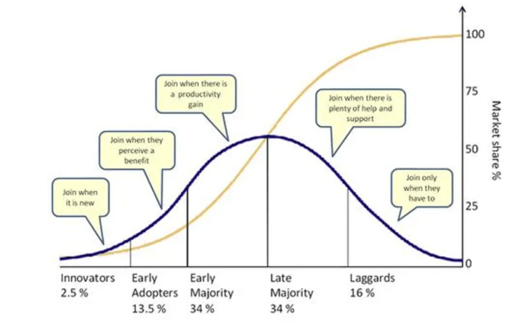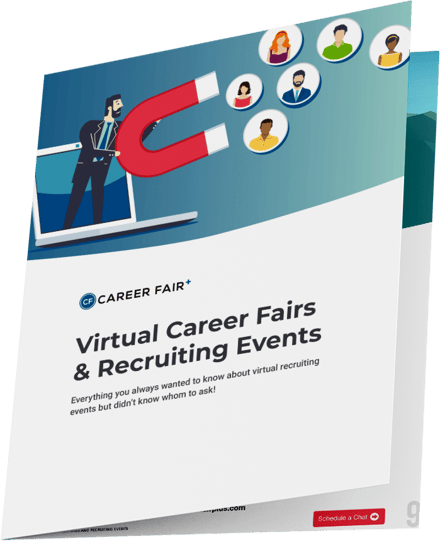Are you one of the hundreds of people lined up to buy The First anything or the last in your circle to use a technology everyone else embraced two years ago? Whether you're leading the charge, closing the ranks, or somewhere in the middle, there's a name for how and when people accept new technology.
In 1962, Everett Rogers1, a professor of Communication Studies, published Diffusion of Innovations to describe his theory of how, why, and at what rate people (and organizations) adopt new ideas and technology.
Why does this matter to career services decades later? Because every time you implement new technology, you have to win over every type of adopter.
Understanding each technology adoption stage means better navigating the adoption process to ensure your team stays productive and attractive to students and employers.
In 5 minutes (and 20 seconds), you’ll discover how the technology adoption life cycle applies to implementing Career Forge | ERM, a new employer relationship management platform for university and college-based career services teams.
Roger’s Technology Adoption Curve and the iPhone
The evolution of the iPhone as an everyday consumer product explains the technology adoption lifecycle theory perfectly. Let’s start with Dennis Pearce’s2 practical chart to illustrate the story we’re about to explore.

Apple introduced the iPhone on January 9, 20073, to a building full of media and people representing the first stage of Roger's adoption curve: innovators. These tech-savvy visionaries were drawn to the new technology’s innovative design and features. Most importantly, they were willing to take a risk on a new and untested product.
Early Adopters started embracing the technology as they discovered its benefits. Unlike innovators, this group was less comfortable with new technology but still intrigued and open to using the iPhone. They were drawn to its sleek design and the convenience of having a phone and internet device in one.
iPhone usage expanded from Adopters to what Rogers defines as the Early Majority. This group tends to be more pragmatic and less willing to take risks. They needed to see this new technology as mainstream before buying it.
The Late Majority, who tend to be more skeptical and resistant to change, adopted the iPhone after it was on the market for a few years. Reluctant at first, they joined existing users based on positive reviews and proven advantages.
Finally, the last stage of the adoption curve is described as Laggards. These people accept new technology only when necessary. Our iPhone example could be because their old phone broke or it was incompatible with current needs, like taking good pictures or accessing the Internet.
By understanding the technology adoption lifecycle theory and how it applies to the iPhone, we can see how different groups of people adopt new technologies at different stages.
Sam, an employer relations specialist at a mid-size private university in the southeast, is implementing Career Forge | ERM to elevate employer relationship management. He wants to humanize the interactions and automate the administrative tasks. Follow along as he applies his knowledge of the adoption life cycle to avoid push back and achieve broader acceptance and better outcomes sooner.
Innovators = Tech Savvy & Curious
Who are your tech-savvy people, eager to experiment with new technologies? Or maybe it's only one person. Either way, they are your innovators and the ideal place to introduce new software, including Career Forge | ERM.
In our example, Sam recognized the need for a better employer relationship management platform and took the initiative to research and identify potential solutions. When he discovered Career Forge | ERM, he worked closely with the Career Forge team to implement the platform and provide feedback. As a result, Sam earned the "Innovator" title, setting the stage for broader adoption. (Pro tip: you can join Sam at the Innovator stage. Onboard Career Forge | ERM this summer before the Fall recruiting crush.)
Early Adopters = Willing and Pragmatic
At this point on the Adoption Curve, your team members follow the innovators' lead and embrace the technology. Additionally, they start encouraging others to do the same.
For Sam--and you-- these Early Adopters are critical. They help you build momentum and enthusiasm about the new software. Customizing Career Forge | ERM and identifying influential early adopters eager to help colleagues learn the platform can accelerate adoption.
Remember, faster widespread adoption means employer relations, engagement tracking, and ROI reporting improve sooner.
Early Majority = Comfortable with Cutting Edge
Your journey along the technology adoption curve revs up when the Early Majority group embraces the new technology. As your Innovators and Adopters demonstrate Career Forge | ERM's value to more people, interest in the productivity benefits grows. This is also where you manage concerns or barriers to adoption that might prevent people from embracing the software.
Sam's story offers good insights at this stage. Moving into the Early Majority phase, certain team members were reluctant to test drive the new platform, let alone use it full-time. In response, Sam hosted training sessions and workshops demonstrating the platform's capabilities, showcasing its benefits, and calming fears over a steep learning curve. Simultaneously, the Career Forge team addressed feedback on technical issues potentially discouraging people from fully embracing the platform.
As a result, the platform continued gaining traction, and more people used it regularly. Moving through the Early Majority stage, the career services team successfully built a community of actively engaged users, improved employer relationships, and positively impacted job search outcomes for their students.
Late Majority = Proven Effectiveness
As the name suggests, this point of the adoption curve means the bulk of the population (or, in this case, a career services team) has already adopted the new technology. The Late Majority group is typically more skeptical and conventional regarding new technology. They usually wait to use the software until it's widely accepted and proven effective.
And they challenge leaders like Sam. Staff resistance, even if only one person, complicates the potential benefits and potentially jeopardizes long-term success. Fortunately, Sam used the reporting and analytics in Career Forge | ERM to demonstrate the platform's significant, positive impact on employer relations.
The software showed Sam that a once highly engaged employer was participating in fewer and fewer recruiting events. So, he reached out. A productive phone call later, Sam updated Career Forge | ERM with the new recruiter's contact information. Because no one told Sam or his team about an internal staff change, their correspondence went to an open but unattended email box. When he also learned the employer was searching for a marketing intern, he connected the company recruiter with a promising candidate the same day. Seeing the new technology in action motivated the Late Majority to learn the platform.
Laggards = Reluctant Joiners
The Laggards, people resistant to change and who might only adopt new technology if forced, are the final segment of the adoption curve. Regulations, employer requirements, or peer pressure could push Laggards into using new technology.
At first, the Laggards on Sam's team hesitated to use the Career Forge | ERM platform. They were used to their old ways of tracking employer relationships and needed to see the value in using a new tool. Until one of them noticed their career services colleagues were producing much more detailed reports on their interactions with employers using the platform. They had accessible, clear records of communications at the company and individual point of contact levels.
Finally, when the Laggards realized they could add custom properties to the platform to effortlessly organize and manage their employer relationships, ultimately helping them achieve better student job search outcomes, they accepted the technology.
The tangible benefits convinced Sam's Laggards to fully adopt Career Forge | ERM.
Roger’s Technology Adoption Curve and Sam's story prove that building momentum with Innovators and Adopters fosters a community of engaged users. Encouraging these two groups calms uncertainty among the Early Majority, Late Majority, and Laggards still uneasy about the imagined challenges of learning new technology.
In addition, showcasing the software's benefits spurs broader adoption and achieves better outcomes for your team across the early talent network. Let anyone hesitant to use the platform see the immediate benefits adopters are enjoying.
Don’t miss your opportunity to upgrade ER before Fall recruiting. Onboard Career Forge | ERM this summer.
1 https://ondigitalmarketing.com/learn/odm/foundations/5-customer-segments-technology-adoption/
2 Dennis Pearce, https://www.informationweek.com/social/how-to-revive-social-business-adoption
